In a happy break from our testing of tiny 9mm handguns, we took up the mantle of trying a few that border on, or maybe exceeded the envelope of, too-big nines. We acquired a trio of surplus guns from Southern Ohio Gun, fondly known as SOG, in the form of a Croatian, a Hungarian, and a German. They were all somewhat used, but not badly abused. The guns are the PHP Model MV ($200), the FEG P9M ($260), and the Sig Sauer P6 ($350). Please note that all these older test guns are not always still available by the time we get them and test them, write it all up and get our test into print. Such was the case with at least the SIG P6 of this test. We tested the three guns with Blazer 124-grain FMJ, American Eagle 115-grain FMJ, Winchester 115-grain BEB, and with Federal 124-grain Hydra-Shok. Here is what we found.
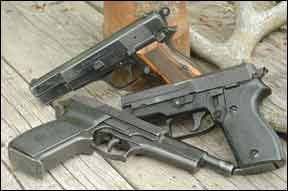
Croatian PHP Model MV 9mm, $200
The letters PHP stand for Prvi Hrvatski Pivtol. We thought you’d like to know that, because it’s better to use the proper name than calling your pistol a “Pffhipp.” According to one source, those words mean “first Croatian pistol,” and they came into being around 1991. We don’t know what MV stands for. There were several barrel lengths offered, and the gun was apparently used by Croat military and police forces. Our test gun has a 5.25-inch barrel, which was in exceptionally nice condition inside. The PHP vaguely resembles a P-38 Walther, but is by no means so kind to the hand that grips it. The gun feels huge and incredibly clumsy, especially when compared with some of the small 9mms we’ve been testing here in Idaho. However, with its new-looking barrel, we had hopes the big gun would at least shoot well, if it didn’t turn any heads for its great good looks.
There are a couple of rather vague plates and panels on the outside of the gun, the function of which escapes the casual viewer. One turned out to be the takedown lever, and the other is the DA link. The safety with its red dot is obvious, as is the magazine release. The mag holds 15 rounds. It drops free like it’s supposed to, and you can shoot the gun with it removed. Because of the tapered magazine and the smooth ramp at the front of the mag well, magazine changing is fast and efficient. Only one came with the gun. However, the mag release does not appear to be reversible, so lefties are left out. There is a large slide-stop release. Both it and the safety are well placed for easy control, we found. The large hammer spur makes the gun easy to cock with the shooting hand. Although the gun is double-action, it’s possible to carry it cocked and locked, one of the few guns we’ve seen that permit that. However, the safety works in the opposite direction from that of a 1911, so it’s not fast nor easy to shoot it from that condition. Also, the hammer falls nicely even though the safety is on, which can be either
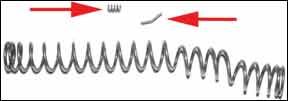
disconcerting or inconvenient, depending on the situation.
The iron sights are actually quite good, if on the small side. They give an excellent sight picture without the rear sight being just a wide bar. It’s tapered on its sides, with enough of a flat on top to be useful. In fact we did some of our best shooting on this test with this gun. The rear seems to be adjustable by drifting, yet it’s not quite dovetailed. The rear seems to be set into a square-sided notch.
The double-action pull was stiff but controllable. It was superior to that of the Sig, which is saying something. The single-action pull was excellent at 4.4 pounds. The DA pull was sticky, just over 14 pounds. The whole gun was big and heavy, tipping the scales at 34 ounces empty.
Takedown was a mystery. There was no paperwork with the gun explaining how the task is supposed to be done. However, our resident gunsmith took a look and rotated the odd-shaped plate on the left side of the gun and then pulled it out. That turned out to be incorrect, and we nearly lost some critical and very tiny parts. Unfortunately, a small spring had been broken inside, which gave us fits by getting in the way of our initial takedown. When we got the slide off, we found out that the innards had been sorely neglected, with signs of corrosion and lack of care over what appeared to be many years. The takedown procedure should have been simple, but was incredibly complex. We describe our takedown procedure here because we found no other resource on the Internet.
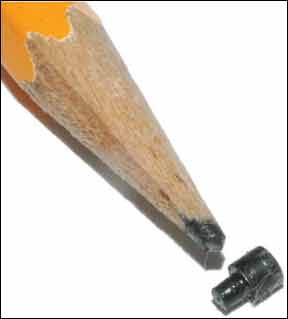
Clear the gun and lock the slide rearward. Rotate the left-side takedown plate clockwise one-quarter turn. DO NOT withdraw it from the gun. Then release the slide slowly until it lines up with the back of the gun and press the trigger to drop the hammer. Move the slide forward until the line on the slide aligns with the front of the receiver. Using an unscrewing motion, remove the spring fully from the gun. Then remove the slide from the frame. To remove the barrel from the slide, push it to the rear and then rotate it 180 degrees to clear the front sight. This may not be perfectly correct, but it worked for us after hours of examination and the near loss of the tiny parts.
As noted, the first time we took the gun apart we were hindered by a tiny broken portion of the barrel-lock retaining spring. It appeared to have been broken or at least cracked a long time, when viewed under strong magnification.
Inside we found a mangled slide-recoil spring. We also learned that the PHP has many, many machined parts, some of which are on the delicate-looking side, so buyer beware of breakage. We found at least one source online for spare parts, so if something does break, you ought to have at least a chance of replacing it. We made an attempt to straighten the recoil spring, and it was quite easy. That means it’ll easily bend again. Most of the inner parts were milled,
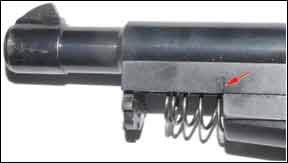
and were very tricky to make. This gun would cost a fortune to make today, so you better grab one while they’re hot, if you’re so inclined.
Reassembly was rather obscure. Again, this is how we did it, and may not be entirely correct, but it did work for us and did no damage. Once the orientation of all the parts is understood, and they’re essentially self-explanatory with a little observation, put the barrel into the slide, then install the barrel lock. (Yours might not have fallen out if the retention spring is not broken. Ours was.) Do not install the recoil spring yet. Holding the barrel/slide/barrel lock assembly upside down, insert it onto the slide, starting from the very front. Do not put it on all the way. When the mark on the slide lines up with the front of the receiver, hold the parts in that position and insert the recoil spring around that tapered mandrel and screw or thread the spring fully into the gun. This will be easy, and the spring will not be bent by following this method. Once the spring is fully in place, retract the slide, making sure to swing the extractor out of the way, and lock it rearward. Then turn the takedown plate counterclockwise 90 degrees. You’re done. Note that you cannot turn the takedown plate without having the slide lock engaged in the slide.
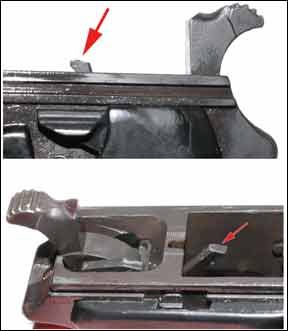
Whew! This was the worst takedown and assembly procedure we’ve ever encountered. There were absolutely no instructions with the gun, but we did it, and now you can too. It was time to shoot the thing.
On the range, for once a good-looking barrel did itself proud. The PHP shot everything quite well, with many groups having three of the five shots touching at 15 yards. However, all was not rosy. We had several failures to feed with the Federal Hydra-Shok load, and concluded the PHP will not reliably feed hollowpoint bullets, though it did okay with the hard-nosed, truncated-cone BEB Winchester loads. Also, the slide would not reliably lock open after the last shot with any of the ammo.
Our Team Said: We thought if you could get past the huge size, clumsy-feeling grip and distasteful appearance, not forgetting the godawful takedown procedure, this was a very good 9mm handgun. We found it to be fascinating, and the more we shot it the more we liked it. More than a curiosity, it shot well and would be a fun addition to any collection. We gave it a B+, but if we rated it based on the takedown it
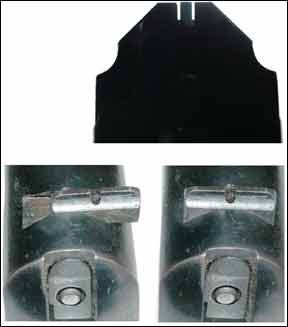
would get a D-.
FEG-Budapest Model P9M 9mm, $250
The FEG was a clone of the Browning Hi-Power. It had all the features and all the faults of the Browning, including a magazine that had to be forcibly removed every time, the inability to fire with the magazine removed, the pinching of the shooting-hand web by the hammer, and more. The trigger pull was terrible, breaking around 10 pounds and varying all over the place. Adding insult was a “lanyard ring” plugged into its butt right where the heel of the hand fell. This made the grip of the gun very uncomfortable. This lanyard ring, which looked more like a cotter pin stuck in the back, would not last 10 seconds if this were our gun. A hacksaw and a punch would clear that garbage off the gun instantly, never mind its possible historic value. Although the exterior of this weapon showed some signs of abuse or lack of care in the form of some pitting on the left side of the slide, the barrel looked excellent inside. We had high hopes for this one too, despite the poor trigger.
The gun originally had a reasonable polish job that left the flats not quite flat, and good bluing too. This was moderately worn here and there, but we didn’t think it needed to be reblued. However, if this gun were to be upgraded with a decent trigger job, extended rear tang and safety, etc., then of course it would greatly benefit from refinishing. The grip panels were walnut, worn so badly as to render the checkering useless. Takedown was classic Browning, and inside we found much the same appearance as the inside of the PHP, lots of grunge, and a general lack of oil. We noted the barrel had what appeared to be incipient rust on its outer surface. We took a bit of Scotch-Brite to the outer surface to see what it was, and sure enough it was rust. Yet the inside of the barrel was pristine, as near to new as made no difference. Why? Go figure.
With the gun checked out and reassembled, we shot our four types of test ammunition through it. Our first group was 5 inches to the

right at 15 yards, but then we noticed the rear sight was finger loose. We could move it nearly out of its dovetail. A good staking was in order. The FEG proceeded to shoot very well, indeed, with two of the loads, the BEB Winchester and the Federal Hydra-Shok.
Our Team Said: In fact, this gun produced generally the best accuracy of the test. It certainly should have done somewhat better with a good trigger. Otherwise, there were no problems of any sort with the gun. We gave it a B+, considering its accuracy and what we thought was pretty good value for the money. It’s a sound gun with some minor problems inside, one that needs care, a trigger job, and maybe a bit of alteration to make it into a really good gun.
Sig Sauer P6 (P225) 9mm, $350
This was an outstanding gun, or so we thought as soon as we picked it up out of its blue plastic box. We prejudged it by its grip, which felt marvelous, very kind to the hand after the other two guns, though the grip was by no means small. The serrations on the front strap combined with the checkered plastic grips seemed to be ideal for control and comfort. The gun had a matte black finish that appeared to be Parkerizing. Once again the barrel appeared to be nearly new inside, though the outside of the gun clearly had seen some use. The right side of the slide appeared to have a date stamp of 9/82.
The gun came with two single-stack magazines, each holding eight rounds. There was an excellent illustrated manual with the gun—in German. Takedown was easiest of this trio. Clear the gun, lock the slide back, and rotate the takedown lever on the left side downward 90 degrees. Ease the slide forward off the gun. Remove the spring and its guide, pull out the barrel and go to cleaning it. Inside, the workmanship was typical Sig, which is to say excellent everywhere. In the age of plastic grip frames and simplified, stamped-part
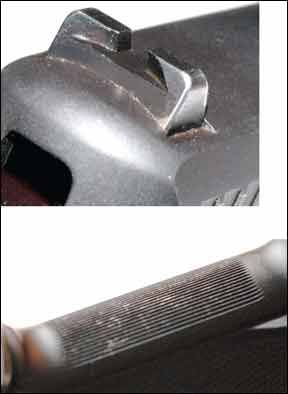
manufacture, this was a delight to inspect. Sig uses an inset block to eliminate much of the tricky machining inside the slide. The entire breech face, the firing pin and its safety, the extractor, etc., are all made as a block that’s inserted into the bottom of the slide and retained by a single pin that is actually two roll pins inside of each other. This would make for very easy maintenance in the field by an armorer. Drive out the pin, remove the faulty breech block, set in a new one, reinsert the pin and you’re done. Mighty clever, we thought. Reassembly was an easy reversal of the takedown procedure, though getting the non-captive spring back in required some work.
On the range we immediately liked the gun. Its sights were the best of the test, large and easy to see, both rear and front set securely in dovetail slots. The double-action trigger pull was heavy, about 12 pounds, not at all to our liking. If ever a gun personified the term “crunchenticker,” this was it. The SA pull was clean and precise, breaking just under 5 pounds.
Somewhat to our dismay, the accuracy was not fantastic, though fully acceptable. We had one stovepipe of a loaded round with the Eagle ammunition midway through a string of five shots. This was not repeated, and we have no idea what the trouble was. We suspect the inner dirt, which we had not thoroughly removed before our shooting test, was the problem. With a thoroughly clean gun, there were exactly no problems.
Our Team Said: Of the three guns, we liked the Sig P6 best, though we confess we had a fondness for the dorky PHP. But the Sig did it all, and though it didn’t have a huge magazine capacity, it did have two magazines, and changing them was fast and easy. For a combat or self-defense weapon, we’d choose the Sig over the other two, mostly because it needed nothing to set it right. For the price, you get a gun very similar to the P225, but those seem to cost about twice the price of this one. The P6 is considered to be one of the finest handguns ever made, or so say some folks. Unfortunately, by the time we went to press we didn’t see any more of them offered by SOG, but you might get lucky. We found a P6 offered by a dealer online for $455 plus $35 shipping, and that was it. But for the price paid for this one, it’s an easy A.
0711-BIG-9MM-ACC-CHRONO-DATA.pdf
0711-CROATIAN-PHP-MODEL-MV.pdf






























